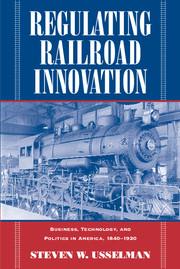Part III - FRICTION IN THE MACHINE, 1904–1920
Published online by Cambridge University Press: 12 August 2009
Summary
The fruitful marriage of engineering and railroading resulted from a particular set of conditions that amplified the potential benefits of engineering methods and masked their inherent limitations. The new century ushered in fundamental changes that would eventually cast the tensions inherent to engineering in a far different light. In the most significant watershed for American railroading since the depression of the 1870s, a wave of mergers and corporate reorganizations swept through the industry. Within a span of just a few years at the turn into the twentieth century, nearly two thirds of the nation's rail mileage fell under the control of seven large systems. Perhaps inevitably, the rapid drive toward consolidation rekindled lingering public concerns about railroad power and the fairness of rates. With encouragement from a new generation of political leaders headed by young President Theodore Roosevelt, calls for national regulation gained new strength and legitimacy. By 1906, when Congress passed the Hepburn Act, the Interstate Commerce Commission had gained unprecedented influence over rates, safety, and other aspects of railroading. Its role would grow steadily more prominent over the subsequent decade and a half.
As railroads confronted new challenges in the regulatory arena, they grappled as well with fundamental changes in the character of demand for their services. With the economic recovery from the depression of the mid-1890s, established lines and newly organized systems found themselves overwhelmed by an unprecedented surge in the volume of traffic.
- Type
- Chapter
- Information
- Regulating Railroad InnovationBusiness, Technology, and Politics in America, 1840–1920, pp. 269 - 272Publisher: Cambridge University PressPrint publication year: 2002



